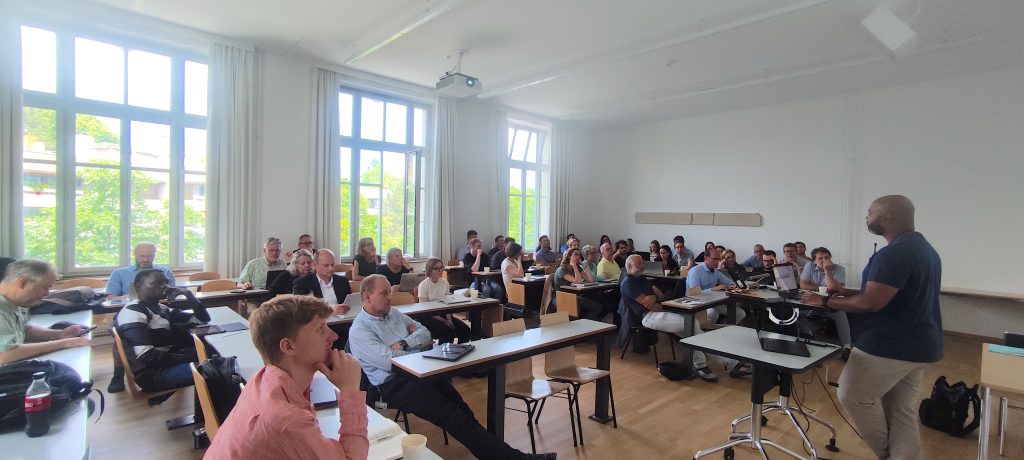Annual report 2024-2025
Editorial
 Surveillance is a Public Good: Fund It Like One. In a tightly connected world, pathogens move faster than paperwork. Outbreaks and even pandemics can ignite when core public-health budgets are brittle, forcing systems to lurch from project to project instead of maintaining the quiet, everyday vigilance that keeps communities safe. Genomics-enabled surveillance is not a luxury; it is the plumbing of modern public health.
Surveillance is a Public Good: Fund It Like One. In a tightly connected world, pathogens move faster than paperwork. Outbreaks and even pandemics can ignite when core public-health budgets are brittle, forcing systems to lurch from project to project instead of maintaining the quiet, everyday vigilance that keeps communities safe. Genomics-enabled surveillance is not a luxury; it is the plumbing of modern public health.
This year, the Swiss Pathogen Surveillance Platform (SPSP) showed what sustained collaboration can deliver. Across federal agencies and universities, teams have further developed an interoperable pipeline, a re-engineered private portal for secure analyses, and transparent public views that support a One Health approach. These are not isolated tools; they are a living infrastructure where data, methods, and people connect.
Most importantly, SPSP underpinned real-world impact. The New England Journal of Medicine paper on diphtheria (Hoefer A, Seth-Smith HMB et al. NEJM 2025), enabled by contributions coordinated through SPSP, demonstrated how rapid, high-quality genomic data can trace transmission, clarify risk, and inform response – even beyond Switzerland. It is a model of how Swiss expertise, shared standards, and timely data save days when days matter most.
The energy at the 2025 Annual Meeting in Bern captured this momentum: practical plans to lower submission barriers, document data flows, align with European requirements, and expand to additional pathogens and resistance modules. These advances are proof of what many teams – bioinformaticians, bench scientists, epidemiologists, clinicians, and public-health officials – achieve together.
But vigilance cannot depend on ad-hoc grants. Although, we re-submitted funding to the Federal Office of Public Health and we also successfully secured a swissuniversity and NIH grant. To keep sequences flowing, dashboards current, and alerts credible, Switzerland needs predictable, core public-health funding for surveillance: stable support for sequencing and metadata curation, resilient infrastructure, expert staffing, and clear governance. Invest in the commons that protects us all. With SPSP as the backbone and this community as its heartbeat, Switzerland can continue to lead – quietly preventing tomorrow’s crises today.
Zürich, 05.09.2025
Prof. Adrian Egli, University of Zurich
Chair, SPSP Executive Board
Introduction
The Swiss Pathogen Surveillance Platform (SPSP) continues to advance its mission of enabling rapid sharing and analysis of pathogen genomic data to support public health surveillance under a One Health approach. With contributions from academic institutions, hospitals, private laboratories and support from federal authorities, SPSP strengthens Switzerland’s preparedness and response capacity for antimicrobial resistance and outbreak detection.
Nationwide Presence at Annual Meeting 2025
The SPSP Annual Meeting 2025, held on 10 June in Bern, brought together 55 participants from 15 institutions (49 on-site, 6 online).
Highlights included:
- Strong representation from the Federal Administration (FOPH, FSVO, IVI, Agroscope).
- Keynote by Prof. Mirko Rossi on the European Food Safety Authority’s (EFSA) Whole Genome Sequencing System and its implications for Swiss data integration.
- Three scientific sessions covering SPSP updates, national/international initiatives using SPSP data, and initiatives of interest to SPSP.
- A panel discussion on incentivizing data submissions, data access, and trust-building within the community.
Major Achievements 2024-2025
1. Digital Infrastructure
In 2024 and 2025, we have focused on our digital infrastructure and expanded specifically the website and the private and public data portals. The intention was to make SPSP more actionable and a tool which can be easily used.
- New SPSP Website launched: a single point of access for information, documentation, and communication.
- New Private Portal deployed:
- The new Portal covers many old and new features e.g., on quality control of the genome data, but also visualizations of phylogenetic trees.
- Refactored IT backbone.
- First implementation for bacteria using the IMMense pipeline (UZH).
- Features include query saving, AMR predictions, outbreak visualizations, and notification services.
- Extended Public Portal:
- Now includes Influenza and RSV data.
- Added phylogenetic visualization with Nextstrain’s Auspice.
- Public SPARQL endpoint introduced for machine findability and FAIR compliance.
2. Bioinformatics Enhancements
Our integrated pipelines were further improved and expanded for viruses and bacteria. These adaptation were based on multiple discussions in the scientific board with inputs from bioinformatic experts in Swiss universities and feedback from the Federal Office of Public Health.
- Integrated pipelines:
- V-pipe (ETHZ/SIB) for SARS-CoV-2 & RSV assembly and quality control.
- VADR for Influenza and RSV automated quality control.
- IMMense for bacterial data, extended with pathogen-specific modules (e.g., Listeria via LisSero).
- pyMLST and MLST typing added for bacterial outbreak detection and monitoring.
- Expanded datasets (number of genomes shared via SPSP):
- SARS-CoV-2: >164’000
- Influenza & RSV: >1’000
- Other viruses: 235
- Bacteria: >700
- Wastewater: >7’100
3. New projects supporting novel developments of SPSP
The team involved applied successful for research grants which help to further develop SPSP. We hope for continued funding also from the Federal Office of Public Health.
- Swissuniversities “Fostering bacterial genomic data FAIRification by extending IMMense and SPSP” (2025-2026).
- SPSP is recognised as a SIB Resource (funding for 2025-2028).
- Swissuniversities “FAIRification of pathogen bioinformatics resources under the Centre for Pathogen Bioinformatics” (2024-2025).
- NIH NIAID Pathogen Data Network (U24AI183840) supporting further developments of the IMMense bioinformatics pipeline (2025-2026).
Panel Discussion Outcomes
During our 2025 Annual Meeting’s we had a panel discussion focusing on how to encourage more data submissions and strengthen trust. There is clearly the challenge that due to cost pressure on the healthcare system less sequencing is performed.
The main takeaways included:
- Action 1: Organize use-case meetings to tailor the Private Portal to different stakeholder needs.
- Action 2: Share more success stories on the website to demonstrate SPSP’s value.
- Action 3: Document data flows, access levels, and responsibilities to enhance transparency.
- Action 4: Explore simplified data submission routes.
- Action 5: Improve handling of problematic submissions despite limited curation resources.
- Action 6: Publish the Standard Operating Procedure for data withdrawal on the website.
We will follow up these action points in the exectuive board meeting over the next months.
Governance and Community
SPSP governance continues to rest on three bodies:
- Executive Board – ultimate decision-making authority.
- Advisory Board – stakeholder representatives providing strategic guidance.
- Scientific Board – invited experts guiding technical and scientific development.
SPSP’s strength lies in its broad community: federal agencies, academic institutions, hospitals, cantonal/private labs, all working under the consortium framework.
New members have joined the Consortium, a warm welcome to them:
ANRESIS, the national reference center NARA, and Agroscope.
Looking Ahead (2025-2026)
Our planned developments for the next year include:
- Bioinformatics:
- Expand to avian Influenza.
- Integrate RSV and SARS-CoV-2 resistance modules.
- Implement EFSA-compliant bacterial typing.
- Expand bacterial analyses to long reads and plasmid analyses.
- Expand analyses to fungi.
- Data Sharing:
- Pilot submissions to EFSA starting mid-2026.
- Automated data exchanges with ANRESIS and NARA.
- Public Portal:
- Expand phylogeny visualization for RSV and bacteria.
- Wastewater Surveillance:
- Explore routine analysis integration.
Acknowledgments
SPSP achievements are made possible by the collaboration of numerous partners:
- Federal agencies: FOPH, FSVO, Agroscope, IVI.
- Hospitals and universities: UZH, USB, CHUV, HUG, UNIBE, ETHZ, and others.
- Funding: federal authorities, Swissuniversities, SPHN, SIB Resources.
With special thanks to all contributors for their dedication to advancing pathogen surveillance in Switzerland!